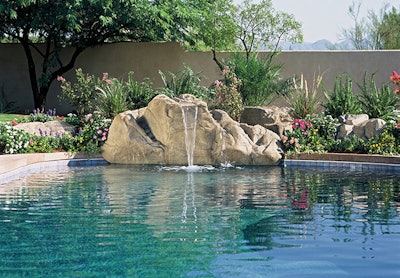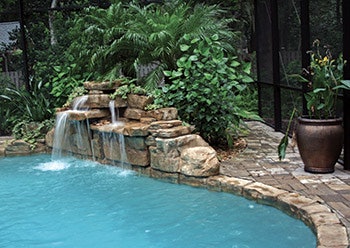
Most of the time when a backyard has a swimming pool, the pool is the focal point of the yard. But what happens when that swimming pool is a Wanda Wallflower — or a “Plain Jane” pool? What should a homeowner do to spice up their backyard? It’s easy: Add an artificial rock waterfall.
Some pool dealers don’t understand the concept of the product, how to install it or to sell it, but others have found that it can separate them from their competitors and help them make thousands of extra dollars on a pool sale while adding minimal time or labor to the project. Artificial rock waterfall features can be added to new or existing pools; are compatible with fiberglass, vinyl liner and gunite pools; and can even be added to aboveground pools.
Faux rock waterfalls are made in a variety of materials. Fiberglass, concrete, concrete GFRC (glass fiber reinforced concrete) or a polyurea /foam combination are just some of the industry options. Waterfalls can come in an assortment of shapes and sizes to fit any budget or backyard, and many waterfalls can tie into other kit accessories to complete the entire pool.


Differences With Real Rock: Faux rock features are easy to install because they are modular, durable and generally lightweight designs. Just take them out of the box, plumb them and put in place. This can give installers peace of mind knowing that their artificial rock feature can be easily duplicated on any job that they sell. In addition, the customer will know what it looks like before the purchase (unless a different color is chosen).
Artificial rock is compatible with vinyl liner pools and affordable for most homeowners. It can also be blended in with real rock. For most artificial rock waterfalls, no extra deck support is required, which makes it easy to use for a remodel job.
How the Waterfalls Are Made: Most artificial rock waterfalls are actually shot from molds that are made from impressions of real rocks. The molds are skillfully handcrafted to create a certain look and designed to ensure that the water flows in the right places. Some waterfalls are designed for straight edges while others fit a certain pool radius. After each waterfall is built they can be tested to ensure there are no leaks.
How to Plumb: For a new construction project, the waterfall area can act as another pool return in the filtration system. Most pool builders will use the same size pipe in plumbing the waterfall as the rest of the pool — usually a 1½-inch to 2-inch rigid schedule 40 PVC. If the plumbing provided by the waterfall manufacturer is smaller in size, a reducer bushing can be used. Most manufacturers suggest using flexible spa hose to connect to the waterfall fitting. A ball valve or three-way valve is recommended to be able to turn the water feature on or off. The valve will also help control the flow of the waterfall as well as the sound of the water. Pool owners often want to adjust this — some may want the waterfall to mask nearby traffic noise while others may prefer a softer sound, and the valve allows them to do that.
Tip: In areas where winterizing is common, it is useful to place a union where the stub up joins the flex hose to the waterfall. This will allow for the waterfall to be winterized or taken off entirely so a winter cover can be more easily installed for the season. Give yourself some extra flexible spa hose to allow for the waterfall to be easily lifted up for removal purposes.
How to Install: Most waterfalls are an on-deck mount application. You can pour concrete footings or position the waterfall onto an existing deck space, then attach by screws or another anchor system provided by the manufacturer. If the waterfall has a lip that goes over the coping it is easy to scribe out the coping profile with a jig saw. Attach the water stub up plumbing to the waterfall fitting.
The importance of landscaping: One of the most common mistakes made when adding a pre-formed waterfall to the side of a swimming pool is not doing anything to soften the edges of the waterfall-to-deck interface. Incorporating natural elements such as potted plants or pockets of plants into the mix will soften the edges and provide more of an oasis effect. Plant pockets that are shaped into the decking around the waterfall can also help provide seating areas near the water feature.
Tip: Have at least three “layers” of plants: tall, medium and short to provide visual interest around the water feature. Make sure to include a variety of leaf colors and textures. Plants such as ornamental grasses, ferns and palms are good choices. Consult with a local plant nursery to find out what grows the best in your vegetation zone. Most importantly, don’t put plants that “drop” their leaves easily close to the pool edge — you don’t want to add extra debris to your pool.
How to clean: Most artificial rock waterfall features designed for swimming pools are resistant to pool chemicals. However, it is always a good idea to watch the water pH, alkalinity, and water hardness (calcium). If calcium buildup is an issue in your area, most of the time a soft bristle brush along with an off-the-shelf cleaning product like CLR or a mild soap will do the trick. But as with most things, it is advised to test a small area in an inconspicuous spot before you do the entire waterfall.
How to Sell: When deciding on which waterfall style to offer the homeowner, it is important to consider the different styles of rock — natural rock formation, a stacked-stone look or something more fountain-like. There are a lot of options out there. Find something that will complement the home or existing backyard environment.
You can sell waterfall kits like a car package: good, better and best. A basic installation could be a small waterfall. A better installation package would be a bigger waterfall with additional flanking landscape boulders. By adding additional landscape boulders to a package it can “lengthen” the waterfall setting along the pool edge. The “best” package could include a large waterfall, additional flanking landscape boulders and matching pool accessory like a jump rock.
Profit summary: Profit can range from $500 to $3,500 per job, and it should only add a few extra man-hours. If you do just 20 installations in a year, you can add a meaningful amount to your bottom line without selling any additional pools.
By offering artificial rock waterfall features to your customers, you can also separate your company from local competitors. It’s fast and easy, and it’s a good way to transform your customer’s pool from a Wanda Wallflower to a Wanda Wonderful.
Comments or thoughts on this article? Please e-mail [email protected].







































